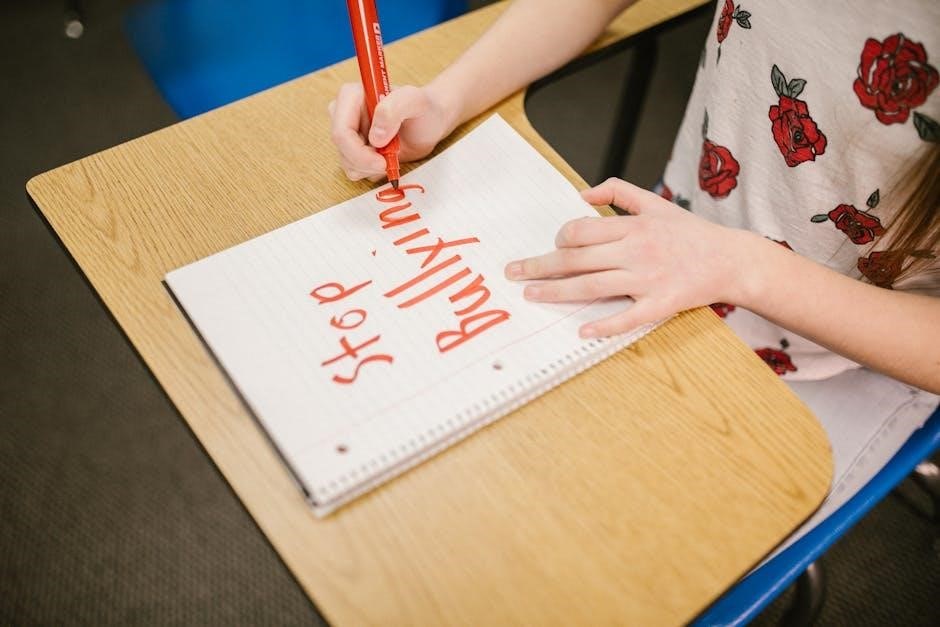5-Minute Warm-up Classroom Activities PDF: A Comprehensive Guide
Looking for quick ways to boost classroom engagement? This guide explores the world of 5-minute warm-up activities, often found in PDF format․ These activities are ideal for sparking creativity, reviewing concepts, or filling those unexpected gaps in lesson time․
In the dynamic landscape of education, maximizing every minute is crucial․ Enter 5-minute warm-up activities: short, engaging exercises designed to kickstart learning and create a positive classroom atmosphere․ These activities serve as energizers, focus sharpeners, and quick review tools, seamlessly integrating into any lesson plan․ They address the common challenge of transitional periods or unexpected spare moments, transforming potential downtime into valuable learning opportunities․
The beauty of 5-minute warm-ups lies in their versatility․ From vocabulary drills and creative writing prompts to mindfulness exercises and physical energizers, the options are boundless․ Many educators rely on readily available PDF resources packed with these activities, offering a convenient and diverse toolkit․ These PDFs often categorize activities by subject, skill, or age group, making it easy to find the perfect fit for any classroom scenario․
Effectively implementing these warm-ups requires minimal preparation and clear instructions․ The key is to choose activities that align with learning objectives and cater to student interests․ Whether it’s a quick game, a thought-provoking question, or a brief movement break, 5-minute warm-ups can significantly enhance student engagement and overall learning outcomes․

Benefits of Short Classroom Activities
Integrating short classroom activities, especially those lasting around 5 minutes, offers a multitude of benefits for both students and teachers․ These activities act as powerful engagement tools, instantly capturing students’ attention and fostering a more interactive learning environment․ They combat monotony, particularly during long lessons or after breaks, revitalizing students and preparing them for focused learning․
Beyond engagement, short activities promote active recall and knowledge reinforcement․ Quick review games or brief quizzes can solidify previously learned concepts, ensuring better retention․ They also provide opportunities for formative assessment, allowing teachers to gauge student understanding and adjust instruction accordingly․ The immediate feedback loop helps students identify areas needing further attention․
Furthermore, these activities cultivate essential skills like critical thinking, problem-solving, and communication․ Even a simple brainstorming session or a quick debate can stimulate intellectual curiosity and encourage collaborative learning․ They also contribute to a positive classroom culture, fostering a sense of community and shared learning experiences․
Moreover, short activities are incredibly adaptable, fitting seamlessly into diverse classroom settings and subject areas․ They require minimal preparation, making them a practical solution for busy teachers․ By strategically incorporating these activities, educators can create a more dynamic, engaging, and effective learning environment for all students․

Types of 5-Minute Warm-up Activities

The realm of 5-minute warm-up activities is incredibly diverse, offering educators a plethora of options to suit various learning objectives and student preferences․ These activities can be broadly categorized based on their focus and intended outcomes․
Vocabulary-based activities, for instance, involve quick word games, synonym challenges, or root word explorations․ These exercises enhance vocabulary acquisition and improve language proficiency․ Speaking and listening activities, on the other hand, emphasize oral communication skills․ These could include brief discussions, impromptu speeches, or listening comprehension exercises based on short audio clips․
Creative writing prompts stimulate imagination and encourage written expression․ Students might be asked to write a short story, a poem, or a descriptive paragraph based on a given prompt․ Mindfulness and relaxation exercises promote well-being and focus․ Simple breathing exercises, guided imagery, or mindful listening activities can help students calm their minds and prepare for learning․
Physical activities and energizers inject movement and energy into the classroom․ These could involve stretching exercises, quick dance breaks, or simple games that get students moving․ Whiteboard art and drawing games encourage visual expression and creativity․ Students can participate in directed drawing activities, collaborative art projects, or quick sketching challenges․
These are just a few examples of the many types of 5-minute warm-up activities available․ The key is to select activities that align with learning goals, cater to student interests, and create a positive and engaging learning environment․
Vocabulary-Based Activities
Vocabulary-based activities are a fantastic way to kickstart a lesson and get students’ minds engaged with language․ Designed for brevity and impact, these 5-minute exercises can significantly enhance word knowledge, improve spelling skills, and reinforce understanding of definitions․ A quick round of synonyms and antonyms is always a winner․ Present a word and challenge students to come up with as many synonyms or antonyms as possible within the time limit․
Another engaging option is a “root word” challenge․ Provide a root word like “port” or “struct” and have students brainstorm words that derive from it․ This activity not only builds vocabulary but also helps students understand word origins and patterns․ Quick spelling bees can also be adapted for vocabulary building․ Instead of simply spelling words, students can be asked to define them or use them in a sentence․
For ESL learners, picture-based vocabulary games can be particularly effective․ Show a picture and have students name as many related words as they can think of․ This helps them associate words with visual cues, solidifying their understanding․ Word association games are another fun and engaging way to expand vocabulary․ Present a word and have students call out related words, encouraging them to make connections and build associations․
These are just a few examples of how vocabulary-based activities can be integrated into the classroom to make learning fun, interactive, and effective․
Speaking and Listening Activities
Engage students immediately with dynamic speaking and listening exercises that sharpen communication skills․ These 5-minute activities are designed to be quick, impactful, and foster a collaborative environment within the classroom․ “Two Truths and a Lie” is a great icebreaker and encourages active listening as students discern fact from fiction․ Each student shares three “facts” about themselves – two true and one false – and the rest of the class guesses which statement is the lie․
Another effective activity is a quick “Think-Pair-Share․” Pose a question related to the day’s lesson, have students think about their answers individually, then pair up to discuss their thoughts before sharing with the whole class․ This promotes both individual reflection and collaborative dialogue․ “One-Minute Speeches” can also build confidence and public speaking skills․ Give students a topic and one minute to prepare a short speech, encouraging them to be concise and engaging․
For younger learners, “Show and Tell” can be a fun way to practice speaking and listening․ Students bring in an object from home and share it with the class, answering questions from their peers․ “Chinese Whispers” is another classic that highlights the importance of clear communication and active listening․ A message is whispered from one student to the next, and the final result is often hilariously different from the original․
These activities promote active participation․
Creative Writing Prompts
Ignite imagination and hone writing skills with quick and engaging creative writing prompts․ These 5-minute bursts of creativity can unlock students’ storytelling potential and provide a welcome break from routine tasks․ Start with a simple sentence starter like, “Suddenly, the door creaked open, and․․․” and challenge students to continue the story in a surprising or imaginative direction․
Another effective prompt is to present a picture – a fantastical landscape, a mysterious object, or an intriguing character – and ask students to write a short description or a brief narrative inspired by the image․ Word association games can also spark creative ideas․ Provide a list of seemingly unrelated words and task students with weaving them into a cohesive story or poem․
For a more structured approach, try “Six-Word Stories,” challenging students to convey a complete narrative using only six words․ This exercise forces concise language and imaginative storytelling․ “If I Were․․․” prompts can also be a fun way to encourage creative thinking․ Ask students to write about what they would do if they were invisible, a superhero, or an animal․
“Write a Travel Brochure” allows students to create marketing material for a real or imaginary location․ These activities encourage creativity․
Mindfulness and Relaxation Exercises
Cultivate a calm and focused classroom environment with short mindfulness and relaxation exercises․ These activities can help students manage stress, improve concentration, and develop emotional regulation skills․ A simple breathing exercise, such as “Square Breathing,” involves inhaling for four counts, holding for four counts, exhaling for four counts, and holding again for four counts, repeated several times․
Another effective technique is mindful listening․ Play a soft chime or bell and instruct students to close their eyes and focus solely on the sound, noticing its beginning, middle, and end․ Body scan meditations can also promote relaxation․ Guide students to focus their attention on different parts of their body, noticing any sensations without judgment․
Visualization exercises can transport students to a peaceful setting․ Ask them to imagine a calming place, such as a beach or a forest, and focus on the details – the sounds, smells, and sights․ Gratitude exercises can also foster a positive mindset․ Have students silently list three things they are grateful for․
These activities can be easily incorporated into the daily routine, providing a moment of calm amidst the demands of the school day․ Mindfulness․
Physical Activities and Energizers
Combat sluggishness and boost energy levels with quick physical activities and energizers․ These activities are particularly useful during afternoon sessions when students may be feeling tired․ Simple stretches, such as arm circles, neck rolls, and torso twists, can improve circulation and flexibility․
A quick game of “Simon Says” can get students moving and following instructions․ Incorporate actions like jumping jacks, hopping on one foot, or touching their toes․ Another energizing activity is “Chair Volleyball․” Have students remain seated and use their hands to hit a balloon or soft ball over a makeshift net;
“Brain Breaks” can also be effective․ These involve short bursts of physical activity, such as dancing to a song or doing a set of jumping jacks․ Encourage students to stand up and move around the classroom for a minute or two․
For a more structured activity, try a quick round of “Follow the Leader․” One student leads the class in a series of movements, and the others follow along․ These physical activities not only energize students but also promote coordination and teamwork․ Remember to adapt the activities to suit the age and abilities of your students․
Whiteboard Art and Drawing Games
Transform your whiteboard into a canvas for creative expression with these quick and engaging art and drawing games․ Whiteboards are a fantastic resource for spontaneous activities when you have a few spare minutes․ “Directed Drawing” is a great option; find simple “how to draw” tutorials online and guide students through creating a picture step-by-step․
“Squiggle Art” is another fun activity․ Draw a random squiggle on the board and have each student turn it into a unique picture․ This encourages imagination and problem-solving skills․ You could also play “Pictionary,” where students take turns drawing clues for their classmates to guess․
“Collaborative Drawing” involves the whole class․ Start a drawing on the board and have each student add something to it, one at a time, creating a collective artwork․ For a vocabulary-focused game, write a word on the board and have students draw a picture that represents it․
These whiteboard activities stimulate creativity, enhance visual skills, and provide a fun break from traditional lessons․ They are also easily adaptable to different age groups and skill levels․ Remember to encourage students to be imaginative and expressive in their artwork․
Adapting Activities for Different Age Groups
The key to successfully implementing 5-minute warm-up activities lies in tailoring them to the specific age group you’re working with․ What captivates a group of kindergartners might not resonate with middle schoolers, and vice versa․ For younger students, focus on activities that are highly visual, interactive, and involve movement․ Simple games, songs, and drawing prompts work well․
With elementary students, you can introduce slightly more complex activities that involve basic vocabulary, simple writing tasks, or teamwork․ Adapt the instructions and expectations to match their developmental stage․ For middle and high school students, aim for activities that encourage critical thinking, creativity, and collaboration․
Consider adapting vocabulary-based games by using age-appropriate words․ Adjust creative writing prompts to reflect their interests and experiences․ Physical activities can be modified to suit their physical capabilities and energy levels․ Mindfulness exercises can be simplified for younger children and made more challenging for older students․
Remember to provide clear instructions and adjust the level of support based on the age group․ Always consider the developmental needs and interests of your students when selecting and adapting 5-minute warm-up activities․
Utilizing ESL Worksheets for Quick Activities
ESL worksheets can be a valuable resource for quick and effective 5-minute activities, particularly in classrooms with English language learners․ These worksheets often provide targeted practice in specific areas, such as vocabulary, grammar, or reading comprehension, making them ideal for focused warm-up sessions․ The key is to select worksheets that are concise, engaging, and aligned with the students’ current language level․
Consider using worksheets that focus on essential vocabulary related to everyday topics or the current lesson․ Fill-in-the-blank exercises, matching activities, or simple sentence-building tasks can be completed quickly and provide valuable reinforcement․ Grammar-focused worksheets can target common errors or review recently learned concepts․
Reading comprehension worksheets with short passages and simple questions can improve reading skills and build confidence․ Many online resources offer free, printable ESL worksheets that can be easily adapted for 5-minute activities․ Remember to provide clear instructions, model the activity if necessary, and offer support to students who need it․
ESL worksheets can be a powerful tool for enhancing language skills in a short amount of time, making them a great addition to your 5-minute warm-up repertoire․
Resources for Finding 5-Minute Activity PDFs
Finding readily available resources for 5-minute classroom activities in PDF format can save teachers valuable time and effort․ Several online platforms offer a wealth of printable activities suitable for various age groups and subject areas․ Websites dedicated to educational resources often have sections specifically for short warm-up exercises․
Teachers Pay Teachers is a popular marketplace where educators share and sell their original resources, including numerous 5-minute activity PDFs․ These resources often cover a wide range of topics, from vocabulary and grammar to creative writing and critical thinking․ ESL websites frequently provide free, downloadable worksheets that can be used for quick language practice․
Many educational blogs and websites offer compilations of 5-minute activities, often with links to printable PDFs․ Search terms like “5-minute classroom activities PDF,” “quick warm-up exercises,” or “ESL activity worksheets” can yield a variety of results․ It’s important to preview the resources to ensure they are age-appropriate, aligned with the curriculum, and engaging for students․
Remember to consider copyright restrictions and terms of use before using any downloaded materials․ By exploring these online resources, teachers can easily find a variety of 5-minute activity PDFs to enhance their classroom instruction․
Implementing 5-Minute Activities Effectively
Effectively integrating 5-minute activities into the classroom requires careful planning and consideration․ These short bursts of engagement can be highly beneficial, but only if implemented strategically․ First, clearly define the purpose of the activity․ Is it to review previously learned material, introduce a new concept, energize students, or simply fill a few spare minutes?
Choose activities that align with the learning objectives and the students’ needs․ Consider the age group, subject matter, and learning styles when selecting an activity․ Prepare all necessary materials in advance to ensure a smooth transition and avoid wasting valuable time․ This might involve printing worksheets, gathering supplies, or setting up a whiteboard․
Provide clear and concise instructions to students before starting the activity․ Ensure they understand the task and any time constraints․ Monitor student engagement and provide support as needed․ Encourage participation and create a positive and supportive learning environment․
After the activity, briefly review the key concepts or learning outcomes․ This helps reinforce the material and provides closure․ Adapt activities as needed based on student feedback and performance․ Flexibility is key to maximizing the effectiveness of 5-minute activities․ By following these guidelines, teachers can seamlessly incorporate these short exercises into their daily routines․




